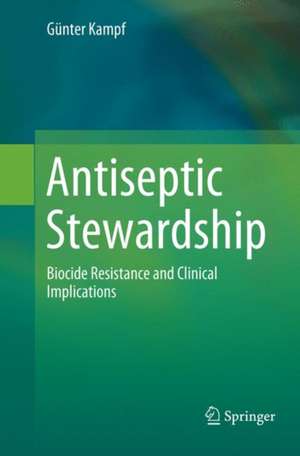Antiseptic Stewardship: Biocide Resistance and Clinical Implications
Autor Günter Kampfen Limba Engleză Paperback – 11 ian 2019
Various antiseptic agents, such as chlorhexidine, are used for different applications, e.g. in healthcare, veterinary medicine, animal production and household products, including cosmetics. However, not all antiseptic agents provide significant health benefits, especially in some products used in human medicine (alcohol-based hand rubs, antimicrobial soaps). While some products (antimicrobial soaps, surface disinfectants, instrument disinfectants, wound antiseptics) may contain one or more biocidal agents with a comparable antimicrobial efficacy but large differences in their potential for microbial adaptation and tolerance. An increased bacterial resistance has been described for various antimicrobial agents, sometimes including a cross-resistance to antibiotics.
The book is the first comprehensive reference resource on antiseptic agents, including their efficacy, natural and acquired resistance, adaptation, and cross-resistance. It also discusses their and appropriate use in terms of a balance between their efficacy and the risk of acquired bacterial resistance / tolerance. Focusing on human and veterinary medicine and household products, it helps readers make informed decisions concerning against antiseptic products based on their composition. The book contributes to reduce any unnecessary selection pressure towards emerging pathogens and to keep the powerful antiseptic agents for all those applications that have a clear benefit (e.g. reduction of healthcare-associated infection).
| Toate formatele și edițiile | Preț | Express |
|---|---|---|
| Paperback (1) | 1938.53 lei 6-8 săpt. | |
| Springer International Publishing – 11 ian 2019 | 1938.53 lei 6-8 săpt. | |
| Hardback (2) | 1778.44 lei 38-44 zile | |
| Springer International Publishing – 20 oct 2024 | 1778.44 lei 38-44 zile | |
| Springer International Publishing – 5 sep 2018 | 1946.03 lei 6-8 săpt. |
Preț: 1938.53 lei
Preț vechi: 2040.56 lei
-5% Nou
Puncte Express: 2908
Preț estimativ în valută:
370.94€ • 404.19$ • 312.57£
370.94€ • 404.19$ • 312.57£
Carte tipărită la comandă
Livrare economică 23 aprilie-07 mai
Preluare comenzi: 021 569.72.76
Specificații
ISBN-13: 9783030075309
ISBN-10: 3030075303
Ilustrații: XLI, 694 p. 20 illus., 17 illus. in color.
Dimensiuni: 155 x 235 mm
Greutate: 1.02 kg
Ediția:Softcover reprint of the original 1st ed. 2018
Editura: Springer International Publishing
Colecția Springer
Locul publicării:Cham, Switzerland
ISBN-10: 3030075303
Ilustrații: XLI, 694 p. 20 illus., 17 illus. in color.
Dimensiuni: 155 x 235 mm
Greutate: 1.02 kg
Ediția:Softcover reprint of the original 1st ed. 2018
Editura: Springer International Publishing
Colecția Springer
Locul publicării:Cham, Switzerland
Cuprins
1. Chemical characterization.- 2. Types of application.- 2a. Approval by ECHA.- 2b. Approval by EPA.- 2c. Amounts per type of application (overall environmental impact).- 3. Spectrum of antimicrobial activity.- 3a. Bactericidal activity.- 3b. Fungicidal activity.- 3c. Mycobactericidal activity.- 3d. Virucidal activity.- 3e. Sporicidal activity.- 4. Natural resistances.- 5. Adaptation after exposure.- 5a. Per type of typical application.- 6. 7. Cross-resistance to other biocidal agents.- 8. Cross-resistances to antibiotics.- 9. Proposal for responsible use (antiseptic stewardship).
Notă biografică
Günter Kampf is an Associated Professor for Hygiene and Environmental Medicine at the University of Greifswald, Germany. He has published more than 180 mostly international articles on various aspects of infection control, such as hand hygiene and surface disinfection. In 2017 he published his second textbook on hand hygiene in German as an editor. A recognized medical specialist in hygiene and environmental medicine, he worked for a manufacturer of chemical disinfectants for 18 years, the last 5 years of which as Director of Science. Since 2016 he has been self-employed and continues his scientific work together with infection control consultancy for hospitals, medical practices and companies with infection control issues.
Textul de pe ultima copertă
VVarious antiseptic agents, such as chlorhexidine, are used for different applications, e.g. in healthcare, veterinary medicine, animal production and household products, including cosmetics. However, not all antiseptic agents provide significant health benefits, especially in some products used in human medicine (alcohol-based hand rubs, antimicrobial soaps). While some products (antimicrobial soaps, surface disinfectants, instrument disinfectants, wound antiseptics) may contain one or more biocidal agents with a comparable antimicrobial efficacy but large differences in their potential for microbial adaptation and tolerance. An increased bacterial resistance has been described for various antimicrobial agents, sometimes including a cross-resistance to antibiotics.
The book is the first comprehensive reference resource on antiseptic agents, including their efficacy, natural and acquired resistance, adaptation, and cross-resistance. It also discusses their and appropriate use in terms of a balance between their efficacy and the risk of acquired bacterial resistance / tolerance. Focusing on human and veterinary medicine and household products, it helps readers make informed decisions concerning against antiseptic products based on their composition. The book contributes to reduce any unnecessary selection pressure towards emerging pathogens and to keep the powerful antiseptic agents for all those applications that have a clear benefit (e.g. reduction of healthcare-associated infection).
Caracteristici
Provides a comprehensive literature overview on efficacy, adaptation, acquired resistance and cross-resistance for various commonly used antiseptic agents Focus on the potential of antiseptics to enhance cross-resistance to antibiotics where multi-resistance has become a major global threat Offers practical guidance for academics, professionals and others to make informed decisions on various antiseptic agents in different types of products (e.g. alcohol-based hand rubs, skin antiseptics etc.) Helps to reduce unnecessary bacterial or fungal selection pressure so that the efficacy of useful antiseptics is not impaired in the future
